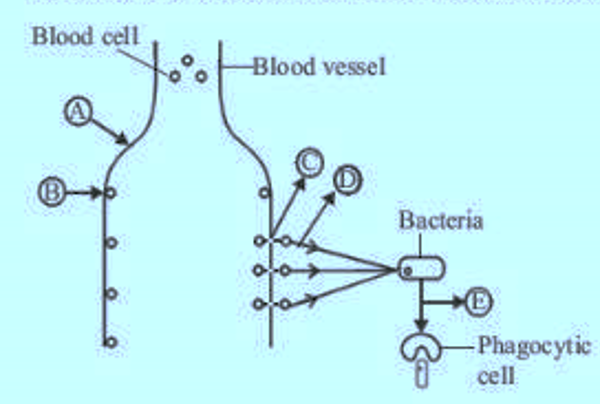
The figure below shows the steps of phagocytosis selected the option of giving correct identification.

A. C – shows diapedesis movement of RBC from dilated vessels.
B. A – shows vasoconstriction due to the effect of histamine.
C. D – shows the chemotactic movement of bacteria to WBC.
D. B – Shows adhesion of monocytes due to decreased rate of blood flow.

Answer
550.2k+ views
Hint:Phagocytosis is a biological process by which a living cell uses its plasma membrane to surround large particles like dead cells or any nutrients or bacteria, viruses and then engulf them to give rise to an internal compartment, known as a phagosome. This is one type of endocytosis.
Complete answer:
According to the above picture,
The ‘A’ portion of the image shows an enlargement of the blood vessels. It means vasodilation occurs instead of vasoconstriction. So, option B is wrong.
The ‘B’ portion of the image shows the adhesion of blood cells to the blood vessels. The small rounds are denoted as blood vessels in the image. The adhesion can only occur when the rate of blood flow is decreased than normal. Monocytes are a type of WBC. So, option D is correct.
The ‘C’ portion of the image shows the attachment of the blood cells to the plasma membrane of the blood vessels. As the blood cells are confirmed as monocytes or WBC in the ‘B’ so it cannot be RBC. So, option A is wrong.
The ‘D’ portion of the image shows the attraction of the WBC to the bacteria. Chemotactic movement is seen in WBC instead of the bacteria. So, option C is wrong.
The ‘E’ portion of the image shows the phagocytosis process.
Hence, the correct answer is option D. B – Shows adhesion of monocyte due to decreases rate of blood flow.
Note: During phagocytosis the bacteria, foreign particles, dying cells are engulfed by phagocytes to protect the body. It works with the cooperation of lysosomes which helps to acidify the environment of the phagosome when it fuses with lysosomes and forms phagolysosomes.
Complete answer:
According to the above picture,
The ‘A’ portion of the image shows an enlargement of the blood vessels. It means vasodilation occurs instead of vasoconstriction. So, option B is wrong.
The ‘B’ portion of the image shows the adhesion of blood cells to the blood vessels. The small rounds are denoted as blood vessels in the image. The adhesion can only occur when the rate of blood flow is decreased than normal. Monocytes are a type of WBC. So, option D is correct.
The ‘C’ portion of the image shows the attachment of the blood cells to the plasma membrane of the blood vessels. As the blood cells are confirmed as monocytes or WBC in the ‘B’ so it cannot be RBC. So, option A is wrong.
The ‘D’ portion of the image shows the attraction of the WBC to the bacteria. Chemotactic movement is seen in WBC instead of the bacteria. So, option C is wrong.
The ‘E’ portion of the image shows the phagocytosis process.
Hence, the correct answer is option D. B – Shows adhesion of monocyte due to decreases rate of blood flow.
Note: During phagocytosis the bacteria, foreign particles, dying cells are engulfed by phagocytes to protect the body. It works with the cooperation of lysosomes which helps to acidify the environment of the phagosome when it fuses with lysosomes and forms phagolysosomes.
Recently Updated Pages
A man running at a speed 5 ms is viewed in the side class 12 physics CBSE

State and explain Hardy Weinbergs Principle class 12 biology CBSE

Which of the following statements is wrong a Amnion class 12 biology CBSE

Two Planoconcave lenses 1 and 2 of glass of refractive class 12 physics CBSE

The compound 2 methyl 2 butene on reaction with NaIO4 class 12 chemistry CBSE

Bacterial cell wall is made up of A Cellulose B Hemicellulose class 12 biology CBSE

Trending doubts
What are the major means of transport Explain each class 12 social science CBSE

Which are the Top 10 Largest Countries of the World?

Draw a labelled sketch of the human eye class 12 physics CBSE

Explain sex determination in humans with line diag class 12 biology CBSE

Give 10 examples of unisexual and bisexual flowers

State the principle of an ac generator and explain class 12 physics CBSE




